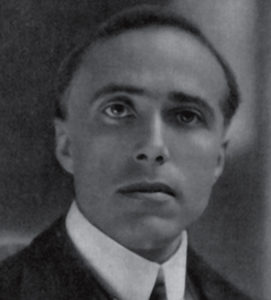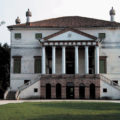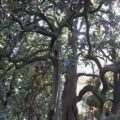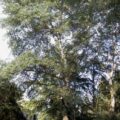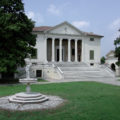Villa Badoer

Popularly known as La Badoera, commissioned by the Venetian noble Francesco Badoer to the famous architect Andrea Palladio from Vicenza. The date of construction is uncertain, even though it is believed that the manor house existed already in 1557 as it appears on the map drawn in the same year and depicting the valleys of San Biagio and Valdentro. The villa appears in the Palladian treatise “I Quattro libri dell’architettura” (The Four books of architecture, 1570) although with some differences from today’s configuration. In the middle of a green lawn surrounded by outbuildings stands the residential building with a monumental pronao preceded by a scenic staircase. On the sides we find the two elegant barchesse, typical Venetian style barns (the “barchessa” in the Venetian villa is a side wing used for dwelling or service purposes) that, with their wide curve intended to enclose the surroinding space as its main feature make it one of the highest Palladian achievements. The villa, as Palladio himself recalls in one of his books, was decorated by Giallo Fiorentino who painted grotesque style figures in the pronao and in its interior. The frescoes were recovered during the restoration work carried out by the Regional Institute for the Venetian Villas.Declared a UNESCO World Heritage Site in 1996, Villa Badoer is now completely open to public and property of the Province of Rovigo that has provided a brilliant conservative restoration.The villa is now the location of important meetings and conferences, exhibitions, theatrical performances, operas and ballet. The northern barchessa, instead, has been the seat of the National Archaeological Museum of Fratta since 2009, with the exhibition of archaeological finds from the Bronze Age.
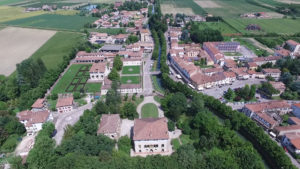
AUDIOGUIDE
National Archeologic Musem
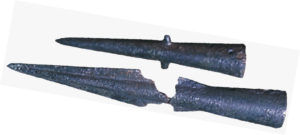
The Archaeological Museum, inaugurated on 21st February 2009, exhibits the finds recovered thanks to the surface research conducted in the protohistoric settlements of the Polesine territory. The testimonies coming from the village are of considerable importance. It is a settlement dating back to a period between 12th and 9th (perhaps early 8th) century BC, attributable to the final phase of the Bronze Age and the early Iron Age. The period of greatest prosperity of the inhabited area is the one between the 11th and 10th century BC, characterized by numerous craft activities, partly linked to raw materials from Eastern and Northern Europe. The testimonies related to the working of metals are also significant. Let’s just think that Frattesina is among the Italian Bronze Age sites with the highest number of fusion moulds, many of which are found in this museum. One of the three smelter storages is also kept here (full of deteriorated bronze objects to be recycled), in which we find brooches, knives, buttons, fragments of bronze bars and many small shovels. There are also gold objects such as a sheet (perhaps part of a disc) and fragments of a tape. Among the other artisan activities exhibited we find glass, ivory and amber processing. The glass, mainly used to make beads, was produced locally: such activity was mostly brought by traders, artisans and prospectors coming from the Eastern Mediterranean to the ancient Delta of the Po river. The amber, found in different shapes, among which the so-called “Tirinto” type, came from the Baltic coasts and reached the artisan centre of Frattesina through the passages of the eastern Alps and the Adige valley, to be channelled towards peninsular Italy, Sicily, the Aegean and the Eastern Mediterranean coasts. Further evidence of the complex network of relations that makes Frattesina a real port of trade, is elephant ivory. Many pieces are found half processed, together with finished products like finely engraved combs. The urns exhibited here, coming from one of the two necropolis of Frattesina and found in Narde, are related to funerary uses. The funeral rite of incineration became commonplace in the final Bronze Age. The ashes were collected and kept inside terracotta urns, usually of biconical shape. The objects left during the burials reflect the rich local handicraft production: numerous bronze ornaments, simple arched brooches, glass beads, amber necklaces, serpentine arched brooches, bone and horn objects.
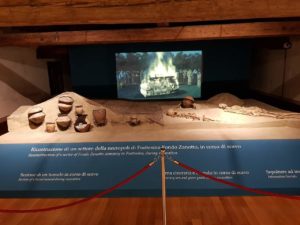
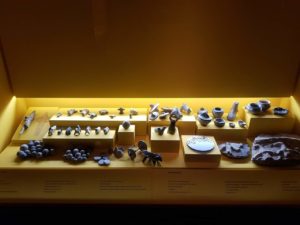
![]()
AUDIOGUIDE
Villa Grimani Molin now Avezzù Pignatelli
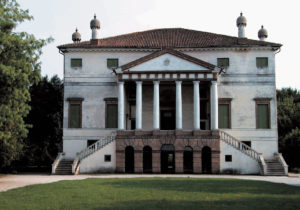
The proximity of the Palladian “Badoèra” certainly inspired the unknown architect of Villa Molin Avezzù, who looks with interest at Palladio’s works, especially the architectural canons of Malcontenta. In the maps of the Venetian Cadastre of 1775, the property of Villa Grimani Molin belongs to the noble Giovanni Francesco Correr. There is a clear separation between the noble court and the working court in the architectural complex: the manor house stands out with two barchesse at the sides, separated one from the other and orthogonal to it. Unlike the nearby Villa Badoer, oriented east-west, the manor of Villa Grimani Molin is oriented north-south, in line with the tradition of villa settlements. The correspondence between the two nearby villas seem to find an explanation also in the similarities of some interior decorations that critics attribute to the same school. In fact, both the Giallo Fiorentino who worked at Villa Badoer and the painter known as “Anonimo Grimani”, to whom the frescoes of Villa Grimani Molin are attributed, come from the circle of Giuseppe Porta Salviati. The iconographic apparatus is mainly based on the themes of love and fertility, already proposed by Veronese.
AUDIOGUIDE
Monument to the Carbonari of Fratta
The monument to the Carbonari of Fratta Polesine is the first monument to be built in Italy after the liberation from the Austrian domination in 1866. For its construction, 4 projects were presented and at the end that of prof. Andrea Provini of Rovigo.
It was inaugurated on June 16, 1867 and the Frattensi called it “Column of the Martyrs”
The execution of the work was entrusted to the sculptor from Verona Grazioso Spazzi. The epigraph was dictated by Don Costante Businaro, patriot of Adria who participated in the defense of Venice.
The work is made of Sant’Ambrogio marble in Valpolicella, its pentagonal shape recalls the Star of Italy. Five large chains surround the stone, a symbol of Austrian slavery. A truncated column, surmounted by a cinerary urn is the emblem of the crushed life of our martyrs. Five palms tied by marble ribbons represent martyrdom and the exaltation of faith. Five inverted torches indicate broken dreams.
The epigraph facing the street indicates: Fratta da Spielberg Venice Ljubljana the painful echo of his martyrs of 1821 collecting his history in this marble. On the other sides the names of the condemned are engraved: Antonio Villa, Fortunato Oroboni, Don Marco Fortini, Giovanni Monti, Giacomo Monti, Antonio Poli, Federico Monti, Vincenzo Zerbini and Domenico Grindati.
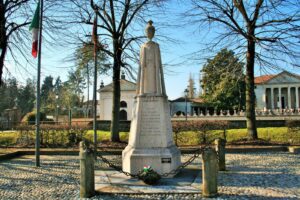
Palazzo Lippomano
Palazzo Lippomano (XVII – XVIII century) represents the heart of Fratta Polesine, both for its urban location – right in the historical centre in front of the beautiful villas Molin Avezzù and Badoer – and because its arcades are home to various commercial activities. The family that gave the name to this building was of Jewish origin, and arrived in Venice between 1378 and 1380. Thanks to a historical map dating back to 1557, we can assume the existence of the palace in Fratta. A more reliable identification of the palace can be found in the Venetian Cadastre of 1775, in which Gasparo Lippomano appears as the owner. The building has an inestimable architectural value and the shape of typical Venetian palaces. It consists of a basement, two floors above the ground and an attic. Main feature of its central body is that it ends in a tympanum. Over the centuries, two wings have been added to the central body, connected by a porticoed loggia and surmounted by a balustrade with rococo terracotta sculptures. The portico was given its present shape around 1856. The dispatch of 1621 to the Doge of Venice and archival documentation show the presence of a cafeteria on the ground floor premises as early as the beginning of the 19th century: initially called San Marco, then Caffè La Fenice and, from 1896 with the arrival of the Matteotti family, it became Caffè Commercio. This is where billiards were first seen, even before Rovigo.
AUDIOGUIDE
Villa Oroboni
The architecture seems to date back to the early 18th century and is asymmetrical since its western part is incomplete. It has two almost identical facades, with only one difference: the southern facade is enlivened by a balcony, replaced by a plain window on the northern facade. A serrated frame adorns the upper gables and runs along the attic, just above the oval windows of the barns. The access to the upper floor is through a scissor staircase that splits after the first ramp. Up until a few years ago two coats of arms were visible at the height of the windows of the first floor. It was possible to see the silhouettes of a stork and an angel, a clear reference to the marriage between the Oroboni and Angeli families. The villa is known for the tragic story of Count Antonio Fortunato Oroboni, a Carbonaro, who was arrested in the night between 6th and 7th January 1819 and died in the Spielberg prison. The villa is currently under restoration.
AUDIOGUIDE
San Bartolomeo Church
The last remaining vestige of the church is a rose-coloured tombstone with an inscription and the coat of arms of the founder. The foundations of the building were laid on August 6th 1338. The church was built on the initiative of an influential personality of the Este court, Riccobono Gonfalonieri from Brescia. The private character of the place of worship accelerated its decline – already started in the 16th century – and its subsequent disappearance. This tombstone is currently the most significant and tangible evidence of medieval times in Fratta Polesine.
AUDIOGUIDE
Palazzo Villa, Cornoldi now Fanan
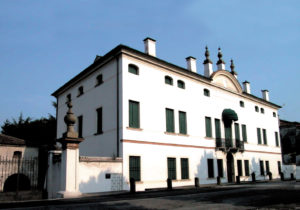
The construction of the villa seems to date back to the early 18th century. At the time, the property belonged to the notary Francesco Villa, as evidenced by the stuccoes in the upper room that show the insignia, marked by a tower with the initials F and V on the sides, surmounted by a flag with the letter N. This is confirmed by information found in the Venetian Cadastre of 1775. The complex consists of the manor and a separate barchessa, perpendicular to it, along the Valdentro, and surrounded by a wall. The portion of land between the two buildings is now used as a garden. At the beginning of the 19th century, the villa was the scene of several meetings of the Carboneria, here in fact on December 12th 1818 Antonio Villa, nephew of Francesco, a Carbonaro from Polesine, was arrested and died in the Spielberg prison with his fellow citizen and friend Antonio Fortunato Oroboni. The Palace, recently restored, hosts one of the most important private music collections in Italy.
AUDIOGUIDE
Palazzo Lippomano Monti ora Viaro
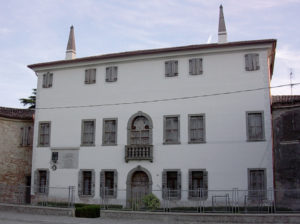
The architectural features of Palazzo Lippomano Monti allow us to hypothesize the construction dates back to the 18th century. However, further sources would date the building to the first half of the 17th century, commissioned by the Labia family. The complex is located at the corner between two streets that meet in a widening, right in front of the parish church of Fratta. The building consists of a three-storey central body, with a pavilion roof, and two curved wings embracing the small courtyard to form a hemicycle. In the Austrian Cadastre of 1852, the house belongs to Giovanni Monti, leveller of the nobleman Gaspare Lippomano. The outbuilding, instead, is owned by his brother Giacomo, also a leveller of the same Lippomano. The Monti brothers were both affiliated to the Carboneria. The great-grandson, Giovanni, born in this palace in January 1900, after a long military career as a pilot, set and still holds the speed record with seaplane (500 Km/h), as evidenced by the plaque visible in the noble facade.
AUDIOGUIDE
Villa Davì now Guzzon Zanobbi
The complex is made up of three buildings arranged in line: the manor, the small oratory and the barchessa. Separated, there is a small outbuilding with neo-gothic features. The manor house faces the road and is slightly behind it. Behind it there is a small park, in which there are some statues and a well, surrounded by a moat, marking the east border of Villa Oroboni. Semenzato supposes a 17th century origin thanks to various elements among which a trifora, composed of three round portals, opening centrally to the main floor. The building seems to have undergone some renovations during the 19th century. In the Venetian Cadastre of 1775, the building was owned by Domenico Vincenzo Davì and his brothers. In 1852, according to the Austrian Cadastre, it still belonged to the Davì family. The maps of the Austrian Cadastre of 1852 show the manor house, the chapel and the barchessa aligned along the southern front. Now the Villa belongs to the Guzzon Zanobbi family.
AUDIOGUIDE
Villa and Parc Labia
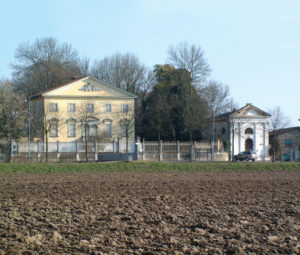
The villa was probably built on the site of the palace of the Procurators of Saint Mark, who managed the “inheritance of Frattesina”, a vast area south-east of Fratta, reclaimed by the Estensi and passed to the Serenissima Republic after the “peace of Bagnolo” in 1484. “La Frattesina” was sold 170 years later to the Labia family, for 1800 ducats, to face the enormous military expenses that Venice had to bear during the war against the Turks. What remains today of the remarkable 18th century complex of Villa Labia is the small church and part of the large garden. The house, bombed in 1945, was demolished the following year to be rebuilt in 1956 according to the 18th century models and with a quite different structure compared to the previous one. A photograph of 1901 shows the old layout. The 19th century park, characterized by a romantic taste and presumably designed by Osvaldo Paletti, was built to complete the villa. Surrounded by a boundary wall, it covers an area of about 15,000 square meters. Inside there are some rare species of trees and two icehouses, as well as an underground canal, coming from the Scortico, and flowing into a small lake. An imposing boundary wall with gratings and wrought iron gates, probably built in the 20th century, separates the building from the road. The villa, originally belonging to the Counts Labia and, in 1775, to Anzolo Maria Labia, became municipal property in 1972 and is now the seat of the “Andrea Palladio” State Middle School.
The park is open to the public every day from Easter Monday to October 30th from 9.00 to 19.00
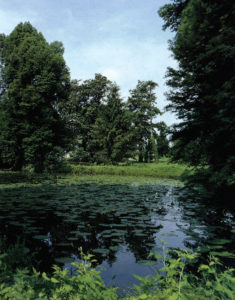
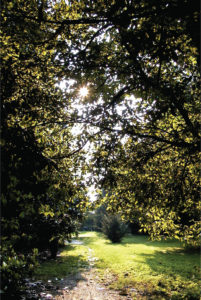
AUDIOGUIDE
Palazzo Campanari
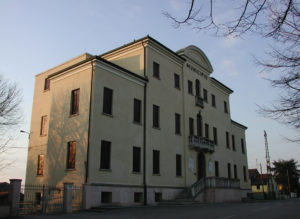
Villa Campanari appears in the maps of the Venetian Cadastre in 1775, in the same location as the manor, right on the road that runs along the right bank of the river Scortico. The property was assigned to Domenico Campanari far beyond 1852. The building consists of an imposing three-storey central body and two lower side wings placed in line with the eastern front and a little backward compared to the western one. Access to the mezzanine floor is allowed by an external staircase. The main facade is crowned by a semi-circular pediment emphasized by a protrusion of the wall of the central body. Three arched portals are one on top of the other in the centre of the facade. The original internal features of the building have been completely lost over the years, as a result of various renovation works carried out to adapt the house to the structure of a town hall. In addition to the manor, on the back, in the inner courtyard, we find a warehouse and a barchessa that in the past served as a repository and a dwelling for the settlers.
AUDIOGUIDE
Palazzo Dolfin Boniotti now “Manegium”

The manor house has an elongated shape and three floors, of which the last attic was originally intended as a granary. The layout is four-sided, with a room moved west from the centre of the building. The southern facade faces the Valdentro drain, while the northern facade faces the inner courtyard. The features of the villa make us assume its construction dates back to the 16th century or, however, that it underwent a radical transformation in the 18th century, with subsequent alterations in the 19th century. The building has been donated by Boniotti’s heirs to the Cultural and Research Group “II Manegium”, an Onlus group of volunteers dealing with historical, artistic, archaeological and ethnographic research in the area that used to be known as “Manegium” in ancient times. The Palace, completely restored, now contains: The Ethnographic Museum on the civilization of work in Polesine; a historical-documentary exhibition on the Polesine Carboneria; the historical-documentary exhibition on Giacomo Matteotti; an exhibition on popular religiosity; a collection of stuffed animals and birds.
AUDIOGUIDE
Villa Dolfin
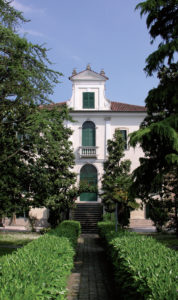
Situated in the centre of the village, the villa consists of a manor with two symmetrical wings and two twin chapels. Registered in the Venetian Cadastre of 1775, Villa Dolfin is a classic example of 18th century architecture, distinguished by an elegant three-storey facade with an imposing staircase leading to the main floor and the typical dormer window with a neoclassical tympanum slimming the building. The meticulousness of the finishing touches of the main facade can also be seen in the rear facade, as the villa had a second access through the Valdentro canal, which was navigable at the time. To this, a series of modern buildings are added: A Church dedicated to the Holy Family and other service buildings that have undergone extensive renovation over time. Today the villa is a Centre for disabled people and a nursing home. The Centre was founded by Beato Luigi Guanella in 1900 who bought the property and the 730 square meter fund from the Dolfin Counts. Its management is entrusted to the Guanelliane Sisters, assisted in their daily tasks by lay staff with various professional skills. Life inside the centre alternates between moments spent in family groups and rehabilitation activities, according to the spiritual and pedagogical teachings of the founder.
AUDIOGUIDE
S. Francesco Church

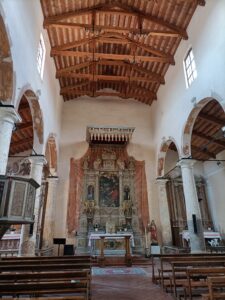
Originally dedicated to S. Maria Assunta and existing since the beginning of the 16th century, it is the result of the enlargement of a church built before and dating back to the beginning of 1100. It was the seat of the Confraternita dei Battuti Bianchi, their name deriving from a white hooded cape covering their face. The church became a privileged place for the meetings of the confraternities of S. Rosario and Cordone di S. Francesco. The Friars Minor of the Province of the Saint from Padua (St. Francis) run this factory, naming it after St. Francis himself, from 1501 until September 17, 1656, the year in which the small convent was shut down by the Serenissima. Inside a crypt located under the right altar, there are the remains of the literate, mathematician and writer Cavalier Giovanni Maria Bonardo, who lived in Fratta in the second half of the 1500s and founded the Frattegiani Shepherds’ Academy. Among the valuable works contained inside are the beautiful and artistic central wooden altar, attributed to the Rodigino Caracchio and the altarpiece of the Assumption, located in the centre of the altar itself, by Maffei.
AUDIOGUIDE
SS. AA. Pietro e Paolo Church
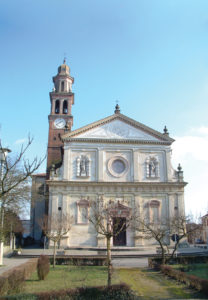
The parish church is dedicated to the Holy Apostles Peter and Paul. Erected in the area of a church already existing in 1123, based on drawings by Zuane Bellettato dating back to 1552, it was finished in 1682, as reported on a plaque on its facade. The Latin-cross shaped building is one of the most imposing churches in the province of Rovigo: it is 55 metres long, 18 metres wide and 25 metres high. The width of the transepts is 35 metres. Its interior, harmoniously decorated with an 18th century style, is adorned with frescoes of Tiepolesque tradition, attributable to Francesco Zugno, with rich carvings and important Venetian sculptures of the 18th century. It also has precious vestments and a canopy. Among the most interesting works are the ceiling frescoes by Francesco Zugno; the stations of the Way of the Cross probably by Zugno himself, recently stolen and replaced with others by local artist; the inner door of the main entrance with angels, friezes, emblems and symbols by Andrea Brustolon; the marble statues of S. Alessio and S. Giuliana Falconieri dating back to 1783 by Giovanni Marchiori, sculptures of S. Benedetto and S. Scolastica, attributable to Giovanni Morlaiter; the two great cherubins, by Baratta and Groppelli adorning the main altar; all the statues on the walls around the church, dating back to 1743 (except that of S. Giovanni Bosco) are by Tommaso Bonazza; the flying canopy of 1783 by Sante Baseggio; the pulpit, of 1859, in which the scene of “Jesus among the Doctors” appears; and finally the parapet of the altar of Holy Forty Martyrs, precious works of gilded carving by master Luigi Voltolini from Lendinara.There is also some canvas of good workmanship, among which stand out: the “Birth of Jesus” and the Adoration of the Magi” by Mattia Bortoloni, the “Circumcision” by Ippolito Scarsella, the “Altarpiece of St. Nicholas of Bari” by Buratto, the “Ecstasy of St. Anthony by Pietro Liberi” and the “Altarpiece of Holy Forty Martyrs”, by an unknown author from Ferrara.
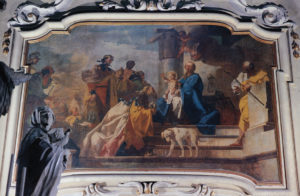
AUDIOGUIDE
Casa Canonica
The parish church dedicated to the Holy Apostles Peter and Paul was built between 1552 and 1682 on the exact spot of a previous church, already documented in 1123. The rectory can be dated back to 1716 and its architecture appears to be typical of the manors of the same period present in the Frattense territory. It is a two-storey house plus an attic and an underground cellar. The plan is tripartite, with a central hall passing through. The southern front shows a portal on the main floor decorated with a horizontal apex and a balcony with a wrought iron parapet; two pinnacles on the roof highlight the central sector. These elements are absent in the northern front, that has a balcony with a stone balustrade and two projecting fireplaces. The facades end in a moulded cornice. The building has remarkable architectural similarities with the nearby Palazzo Monti, and together they enclose the parish church in the centre.
AUDIOGUIDE
Paolino Church
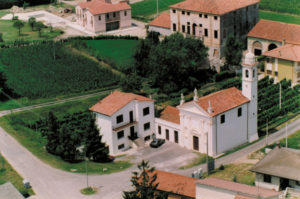
The history of the Oratory of S. Maria del Rosario di Paolino goes hand in hand with that of Villa Corner, now known as Bellettato. The oratory was already present in 1552, when Count Marcantonio Cornaro lived in the villa and also owned a private oratory. The complex is situated near the Canalbianco, at the extreme south of the municipal territory of Fratta Polesine and represents the construction effort of the Corner family along the Canalbianco completed by a second “Cà Cornera” in Zaffarda, “La Palazzina” in Cà Moro di S.Bellino and, Villa “Nani Mocenigo” in Canda. The religious service at the oratory of the villa has been ensured since 1765 with a stable priest, financially supported by the noble Corner family. In 1842 there was a change of ownership, passing to the Crestani family and from these to the Tasso brothers, with whom the oratory experienced a phase of abandonment. Only with the new owner Leopoldo Maragno, in 1885, the cult to the Blessed Virgin of the Rosary was restored, thanks to the spirituality of the inhabitants. Maragno’s sons, in 1956, gave the oratory to the Bishop of Adria and Rovigo to build a new parish church.
AUDIOGUIDE
Mulino “al Pizzon”
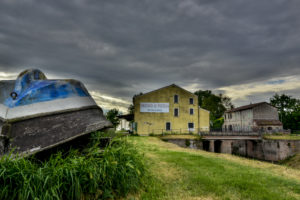
The point of confluence between the Scortico river and the Canalbianco, in the locality of Pizzon of Fratta, is a very unique place for its landscape as well as for its agricultural, architecture and industrial archaeology. As for this latter one, we find two important buildings: the first is a big mill (mulinon), the only one that worked with water in a completely flat land like Polesine, exploiting the difference in height between the Scortico and the Canalbianco. Registered in the Austrian Cadastre of 1841, it was probably built in the 18th century, and is now being renovated for accommodation purposes. Kept running and operating as recently as 1962, the imposing machinery of the mill is still intact. The second is a navigation basin, supported by Vincian doors with windows that still exist today. The basins are the testimony of one of the first waterways in Polesine, planted in the mid-19th century and retracing, in terms of industrial transport, the waterway already navigated by the Venetian nobles to get to their Villas in Fratta in 1500, including the Palladian villas Badoer and Grimani Molin.
AUDIOGUIDE
Casa Matteotti

Giacomo Matteotti was a brave man from Fratta who, in the years between the two wars, dared to oppose the advent of a new ruler, paying his love for justice and freedom with his own life. Graduated in law, Matteotti was a member of the Socialist Party: intelligent, zealous and passionate supporter of the rights of the humblest classes, he was elected deputy in the College of Ferrara. Matteotti was killed in a cowardly and vicious manner on June 10th 1924 for denouncing the electoral fraud that brought the Fascist party to power. He now rests in an austere mausoleum in the cemetery of Fratta. The House, dating back to the 18th century, seems to have undergone alterations and additions, especially during a rehashing in the 19th century and in 1933. The house of Giacomo Matteotti became a House-Museum and in December 2017 it was acknowledged as a National Monument.
